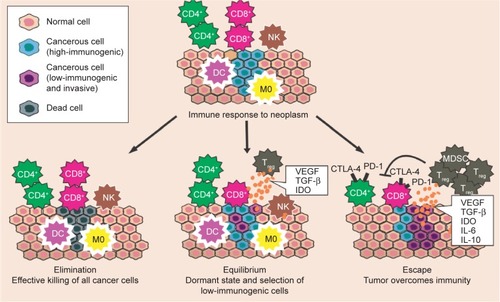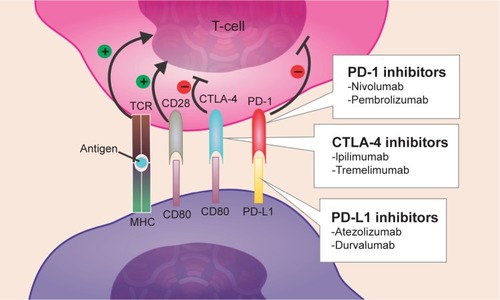Figures & data
Figure 1 Immunoediting mechanism.
Notes: Immunoediting occurs in three phases: elimination, equilibrium, and escape. Elimination is a phase in which both innate and adaptive immunities are successful in eliminating tumor cells before clinical investigation is even possible. Equilibrium is when tumor cells survive the elimination phase but keep coexisting with their host while being strictly controlled by immune defenses. Escape is when tumor cells gain the ability to circumvent immune responses and emerge as progressively growing, visible tumors.
Abbreviations: DC, dendritic cell; M0, macrophage; NK, natural killer cell; Treg, regulatory T-cell; MDSC, myeloid-derived suppressor cell.
Abbreviations: DC, dendritic cell; M0, macrophage; NK, natural killer cell; Treg, regulatory T-cell; MDSC, myeloid-derived suppressor cell.

Figure 2 Mechanism of action of immune checkpoint inhibitors.
Notes: Tregs depend on the activity of CTLA-4, PD-1, and PD-L1 to induce immunosuppression. Ipilimumab and tremelimumab are monoclonal antibodies that inhibit CTLA-4, while nivolumab, pembrolizumab, atezolizumab, and durvalumab inhibit PD-1 and PD-L1. These drugs act by reducing immuno checkpoint activity on a Treg-rich microenvironment, thus diminishing tumor evasion.
Abbreviations: Tregs, regulatory T-cells; TCR, T-cell receptor; MHC, major histocompatibility complex.
Abbreviations: Tregs, regulatory T-cells; TCR, T-cell receptor; MHC, major histocompatibility complex.

Table 1 Efficacy and safety of immunotherapies for NSCLC
